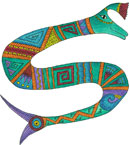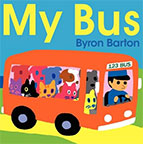 My Bus My Bus
by Byron Barton
Ages 4–8
This bus driver on this colorful bus picks up dogs and cats waiting at the bus stops: one dog, two cats, etc. At various destinations — the airport, the harbor, the train station — animals depart the bus, providing multiple opportunities to add, subtract, and examine sets along the way. |
|
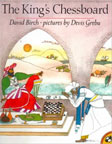 The
King’s Chessboard The
King’s Chessboard
by David Birch
Ages 6–13
Number
The power of doubling for 2nd–6th grade
students. |
|
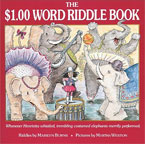 The
$1.00 Word Riddle Book The
$1.00 Word Riddle Book
by Marilyn Burns
Ages 8–12
Number
Riddles give clues for finding
words worth $1.00 using a simple code: a=1¢, b=2¢,
etc. |
|
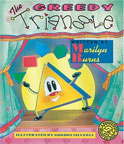 The
Greedy Triangle The
Greedy Triangle
by Marilyn Burns
Ages 5–9
Geometry
Colorful introduction to geometric
shapes for K–3rd grade students. |
|
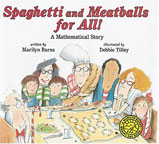 Spaghetti
and Meatballs for All! Spaghetti
and Meatballs for All!
by Marilyn Burns
Ages 6–10
Area & Perimeter
Clever introduction to area and perimeter
concepts for 2nd–4th grade students. |
|
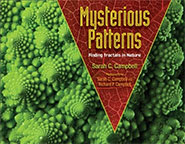 Mysterious Patterns: Finding Fractals in Nature Mysterious Patterns: Finding Fractals in Nature
by Sarah C. Campbell
Ages 5–7
This elegant book simply explains the concepts of fractals with pictures from nature illustrating that every fractal shape has smaller parts that look like the whole shape. Color photograph encourage young readers to look more closely at natural objects while appreciating their intricate shapes. |
|
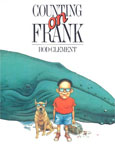 Counting
on Frank Counting
on Frank
by Rod Clement
Ages 4–8
5–10
Measurement
Amusing size and measurement examples
for 1st–4th grade students. |
|
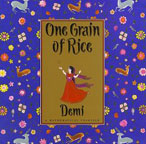 The
King’s Chessboard The
King’s Chessboard
by Demi
Ages 5–10
Number
The power of doubling for 1st–4th
grade students. |
|
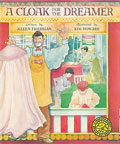 A
Cloak for the Dreamer A
Cloak for the Dreamer
by Aileen Friedman
Ages 5–9
Geometry
Introduction to the relationship between
geometric shapes for Kinder–4th grade students. |
|
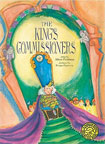 The
King’s Commissioners The
King’s Commissioners
by Aileen Friedman
Ages7–12
Multiplication
Colorful presentation of the connection
between counting and multiplication for 2nd–5th grade students. |
|
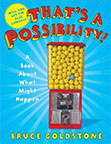 That’s a Possibility!: A Book About What Might Happen That’s a Possibility!: A Book About What Might Happen
by Bruce Goldstone
Ages 7–10
Beginning with the basic concepts of possibility, certainty, and impossibility, this accessible book explores probability. Photographs and digital illustrations place the situations firmly in the real world. “Will an elephant hatch from this egg? That’s impossible!” An illustration of a field of purple flowers with only two yellow ones demonstrates what is probable. Clear scenarios and simple explanations make the often confusing topic of probability easy to grasp. |
|
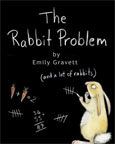 The
Rabbit Problem The
Rabbit Problem
by Emily Gravett
Ages 4–8
This whimsical book addresses
Fibonacci’s question: “If a pair of baby rabbits
are put in a field, how many pairs will there be at
the end of each month? After each year?” Opening
like a calendar, the 12 pages record a full year of
the rabbit experiment, beginning with Lonely and Chalk,
and including a Baby Book for their first born, a ration
book from the carrot shortage, and hilarious documentation
of the growing rabbit population. The beautifully detailed
illustrations build to a surprising pop-up ending. |
|
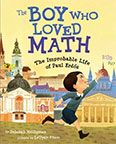 The Boy Who Loved Math: The Improbable Life of Paul Erdos The Boy Who Loved Math: The Improbable Life of Paul Erdos
by Deborah Heiligman, LeUyen Pham
Ages 3–8
Paul Erdos loved math from the time he was a small boy, but he was unhappy with all the rules he had to follow at school and convinced his mother to let him study at home. Known as “The Magician from Budapest,” at the age of four Paul could calculate in his head the number of seconds lived when given a birth date, but he never mastered common life tasks like cooking, laundry, or driving a car. Instead, he flitted around the world, sleeping on the couches of anyone interested in talking math with him. This accessible book celebrates an unconventional and brilliant mathematician in both words and illustrations. |
|
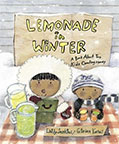 Lemonade in Winter: A Book About Two Kids Counting Money Lemonade in Winter: A Book About Two Kids Counting Money
by Emily Jenkins, G. Brian Karas
Ages 3–7
Pauline and her little brother John-John are positive that they can make a fortune selling lemonade in the middle of winter. Their parents aren’t so sure, but the siblings persevere and work together to advertise and sell their wares. Readers will enjoy counting out the coins for each sale as they enjoy the trust and companionship of the entrepreneurial siblings. |
| |
|
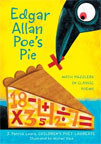 Edgar
Allan Poe’s Pie: Math Puzzlers in Classic Poems Edgar
Allan Poe’s Pie: Math Puzzlers in Classic Poems
by J. Patrick Lewis, Michael Slack
Ages 6–9
Poet laureate Lewis transforms
famous poems (like “The Raven” by Edgar
Allan Poe, “April Rain Song” by Langston Hughes, “The
Termite” by Ogden Nash) into humorous word problems.
Brightly colored illustrations complement the offbeat
mix of language and mathematics, sure to delight children
and adults alike. |
|
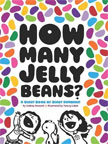 How
Many Jelly Beans? How
Many Jelly Beans?
by Andrea Menotti, Yancey Labat
Ages 4–8
Emma and Aiden can’t decide
how many jelly beans is enough. Is 10 too few? Is 1000
too many? When asked how many they want, the two begin
an escalating boasting match of how many they need.
The bright jelly beans illustrate the numbers: 500
cover a coffee table, 1000 appear on the days of a
calendar year, one million take up a 10-panel foldout
finale. This large-format book provides an engaging
context for a child-friendly exploration of large numbers. |
|
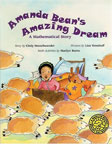 Amanda
Bean’s Amazing Dream Amanda
Bean’s Amazing Dream
by Cindy Neuschwander
Ages 5–9
Multiplication
Fun introduction to multiplication
for 1st–3rd grade students. |
|
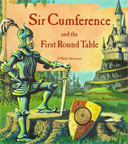 Sir
Cumference and the First Round Table Sir
Cumference and the First Round Table
by Cindy Neuschwander
Ages 7–12
Geometry
Introduces 2nd–5th grade students
to radius and circumference. |
|
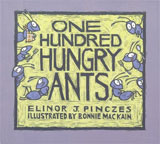 One
Hundred Hungry Ants One
Hundred Hungry Ants
by Elinor J. Pinczes
Ages 4–9
Factoring
A rhyming introduction to factoring
for Kinder–4th grade students. |
|
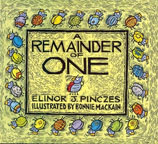 A
Remainder of One A
Remainder of One
by Elinor J. Pinczes
Ages 4–9
Division
A rhyming introduction to division
with remainders for Kinder–4th grade students. |
|
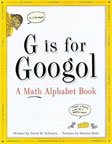 G
Is for Googol: A Math Alphabet Book G
Is for Googol: A Math Alphabet Book
by David M. Schwartz, Marissa Moss
Ages 9–12
This clever math alphabet books
takes readers through 26+ important math ideas and concepts
in an amusing and entertaining way. The informative and
light-hearted text is perfectly paired with bright cartoon-like
illustrations, bringing the mathematics alive. Students
and teachers alike will enjoy exploring this rich book. |
|
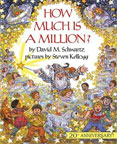 How
Much is a Million? How
Much is a Million?
by David M. Schwartz
Ages 6–12
Number
Graphics help 1st–5th grade students
conceptualize the immensity of numbers. |
|
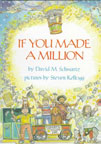 If
You Made a Million If
You Made a Million
by David M. Schwartz
Ages 6–12
Number
This funny and accessible book 2nd–5th
grade students explores money, saving, spending, interest,
mortgages, etc. |
|
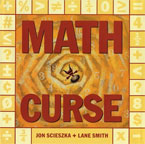 Math
Curse Math
Curse
by Jon Scieszka
Ages 7–up
The narrator is afflicted with
a “math curse” and her entire day becomes
a series of math problems. Hilarious text with striking
illustrations by Lane Smith. |
|
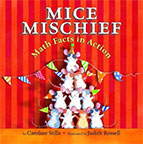 Mice Mischief: Math Facts in Action Mice Mischief: Math Facts in Action
by Caroline Stills, Judith Rossell
Ages 3–6
Combinations of 10
Ten lively and playful little mice demonstrate all the different ways that the numbers from 1 to 9 can add up to 10. Throughout the book, an decreasing number of mice are doing useful chores while an increasing number are goofing off — Eight mice cook pancakes while two juggle fruit: 8 + 2 = 10. |
|
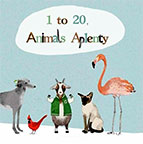 1 to 20, Animals Aplenty 1 to 20, Animals Aplenty
by Katie Viggers
Ages 3–7
A menagerie of animals illustrates the numbers from one to twenty both numerically and as a quantity. The rhyming text adds to the fun of animals decked out in amusing apparel or using silly props — “3 llamas wearing pajamas” and “16 chickens reading Dickens”. Specific breeds and types of animals are identified — among the “7 pigs wearing wigs” are a Tamworth with a pompadour and a Gloucester Old Spot sporting a green Mohawk. |
| |
|
